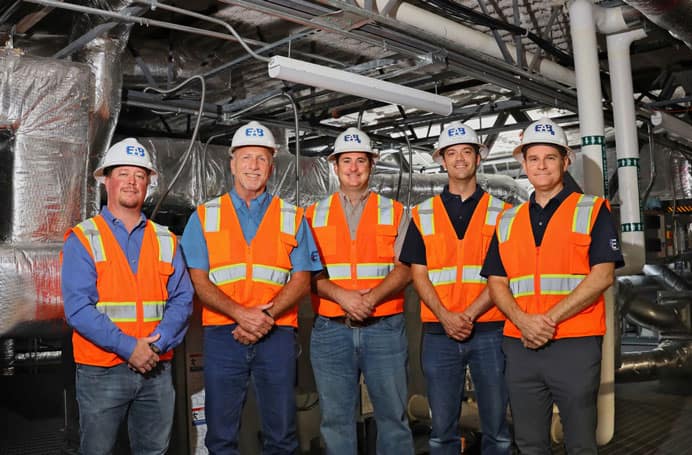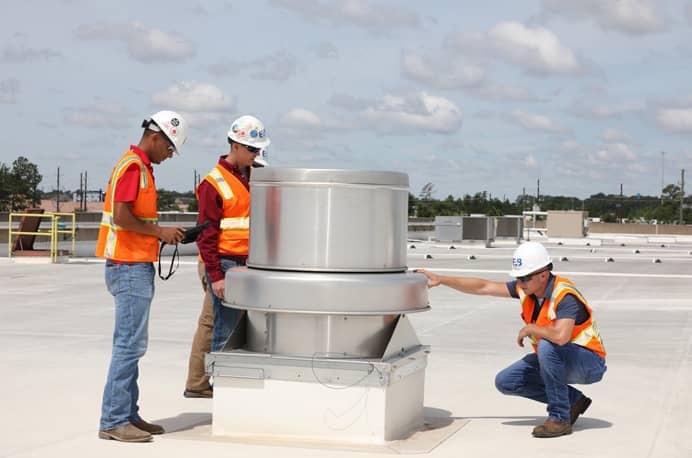
What is air balancing?
Air balancing, or more formally known as Testing, Adjusting and Balancing (TAB), is the process of measuring and adjusting the performance characteristics of the Heating, Ventilating and Air Conditioning (HVAC) systems to ensure optimum operation and conformity with the system design intent. In a simpler form, air balancing ensures that the forced air systems in a facility are performing as intended. In many facilities, the HVAC systems have various issues that cause underperformance. Having a TAB firm perform air balancing services on an existing system can help to diagnose these underperforming systems and rectify some of the problems. Common underperformance issues that may be solved by air balancing are low airflow, poor air distribution and poor thermal comfort control across a system environment. Other common causes of underperformance that cannot be solved with air balancing alone are duct leakage, dirty or poorly maintained equipment, and improperly functioning control sequences. Air balancing services can help to identify these issues.
Air balancing is typically performed upon initial installation of a new HVAC system or when an existing system requires major changes. A qualified TAB firm should be engaged to completely measure all performance characteristics of the system such as airflow, pressures, temperatures, fan and motor speeds as well as electrical consumption. After measuring these parameters as part of the air balancing procedures, the TAB firm can determine whether the system is operating as designed or rated by the equipment manufacturer. If performance deficiencies are found, such as low airflow, inappropriate air distribution, or incorrect pressurization, the TAB firm can typically adjust the systems to meet the design intent if sufficient capacity and components exist in the system.
Components that are critical for proper air balancing are dampers installed in the ductwork branch lines wherever the system divides the air to different areas as well as various types of speed control for the system fans. The TAB firm will measure individual airflows and utilize the dampers to proportion the airflow appropriately within the system. As part of the air balance, the TAB firm will also measure total airflow, pressure drops across the equipment and components as well as thermal performance across heating and cooling coils. If total airflow is low, the TAB firm may speed up the fan system if additional capacity exists, but only after measuring the electrical loading on the motors serving the fans to ensure the additional load will not exceed the motor horsepower rating.
Fan speeds can be constant or variable. Constant volume systems always provide the same fan airflow because the fan always operates at the same speed. Typically, the fan speed is controlled by a set of pulleys with a mechanical ratio to the motor speed. Sometimes, these pulleys can be adjusted to change the fan speed, but often significant speed changes will require a pulley change to achieve the desired fan speed. Variable speed systems modulate the speed of the motor either using internal circuitry or external variable speed drives (VFD). Typically, the airflow in a variable volume system is also modulated by dampers and airflow sensors installed throughout the system. When air balancing, the TAB firm will calculate the fan speed required to achieve the desired airflow based upon the initial system measurements.
What are the benefits of air balancing?
Energy Efficiency
Modern buildings are complex architectural creations. The primary consumer of energy in a modern commercial facility is HVAC equipment. The amount of energy consumed is determined by the architectural construction of the building, the physical orientation of the building, the climate where the building is located and the activities within the facility. All these variables are analyzed when an HVAC system is designed properly. Therefore, if the HVAC systems are not air balanced or not properly maintained, the energy efficiency of the building will not perform as designed. Many existing buildings have significant HVAC issues. Performing air balancing on these facilities often results in better energy efficiency.
Indoor Comfort
In addition to energy efficiency, modern facilities are designed around occupant comfort. If the users of the facility are comfortable, they should perform their functions more efficiently. When the HVAC systems in a facility are not operating efficiently or as designed, occupant comfort can suffer. This is often the most evident indicator that a building’s HVAC system has issues. Proper air balancing by a qualified TAB firm can often correct some of these occupant comfort issues and identify other problems that may need to be resolved to achieve an optimum operating facility.
Occupant Safety
The HVAC systems in most facilities are meant to provide occupant comfort and tenable space conditions for the intended activities. However, some facilities, such as healthcare, research and high occupancy facilities rely on the HVAC systems for occupant safety as well. In these facilities, it is most important that a qualified air balance is completed to ensure adequate ventilation rates, space pressurization and life safety sequencing. A qualified TAB firm must be retained and provide regular on-going measurements in critical spaces (i.e. operating rooms, biosafety labs, etc.) to ensure the space is safe for the occupants.
How to perform HVAC air balancing

The first step to perform a high-quality air balance is to ensure the TAB firm has accurate information regarding the components of the HVAC system. Design documents, equipment submittals, repair records and previous air balance reports are all critical data for the TAB firm. In addition, trend data from the building automation system and maintenance requests from occupants can help to identify problem areas in existing facilities and help the TAB firm troubleshoot issues.
Typically, the TAB firm will begin the air balance “on paper” by analyzing the entire distribution system, codifying the outlets for identification and measurement in the field. Equipment manufacturer’s data and design data will be reviewed to determine the design capacity of fan systems and air handling units. Control drawings and submittals will be reviewed to confirm design intent of control sequences. Control Verification procedures can then be prepared.
In the field, the TAB firm will begin the air balance by observing the installation of the entire system, ensuring dampers and valves are accessible and in the correct position and noting any issues that deviate from the design intent or could cause operational problems. Next, utilizing specialized instruments, the TAB firm will measure and record flows, pressures, equipment speeds, electrical consumption, and thermal characteristics of all components in the HVAC system undergoing air balancing. The TAB firm will then analyze the data and adjust flows and pressures to try to achieve the design intent and / or resolve operational issues.
In addition to basic air balancing measurements, the TAB firm may measure thermal capacities, verify control sequences meet design intent and verify functionality of life safety equipment such as smoke control systems.
The final step in the air balancing process is to compile all of the data into a written technical report that should provide an overall summary of the operating state of the systems, any outstanding deficiencies and suggestions for improvement.
What to look for in an air test and balance report
According to the Associated Air Balance Council’s ANSI National Standards for Total System Balance, the report should be a “complete record of HVAC system performance, including conditions of operation, items outstanding, and any deviations found…” This should include narratives identifying design intent and operation of equipment, actual measured performance data and any known deviations or issues.
The air balance report should be organized by system and include equipment schematics noting measurement locations, design drawings with component codes noted, equipment submittals and other relevant supporting documents used in the air balance process.
Why air balancing matters
Air balancing ensures the proper function of the heating and cooling systems and the timely testing, adjusting, and balancing safeguards of your system. It restores existing mechanical HVAC systems to their optimum operating level, supports monetary and energy efficiency while improving indoor comfort. Air balancing is vital to keeping facilities not only comfortable but safe.
